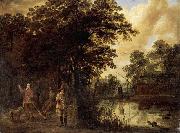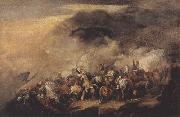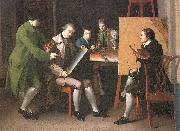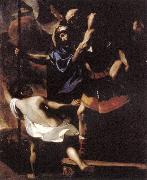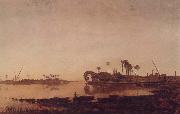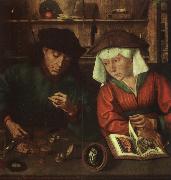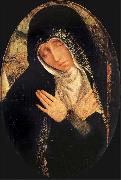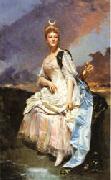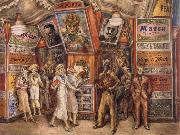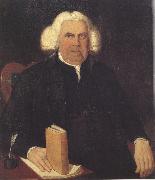|
|
|
|
|
|
|
|
|
|
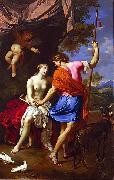 |
Nicolas Mignard
|
|
(1606-1668) was a French 17th Century painter. He spent most of his active life in Avignon and was the older brother of Pierre Mignard.
Nicolas Mignard was born in Troyes in 1606. There, he studied painting with a local master. After traveling to Fontainebleau, Mignard came to Avignon in 1632. He then traveled to Rome with Cardinal Archbishop of Lyon. Mignard came back to Avignon in 1636, after having executed multiple series of etching in Rome. There, he mostly painted for religious institutions. Mignard spent the end of his life in Paris, where he became a successful portrait painter. Mignard left Paris after a visit of King Louis XIV and his Court in Avignon. King Louis XIV decided to bring Mignard to Paris. Mignard eventually joined the Academie Royale.
Mignardes spending most of his life in Avignon made his career somewhat overshadowed by his little brother Pierre, who was installed in Paris. After his death, paintings by Nicolas Mignard mostly stayed in Avignon or in small cities around Avignon. During the French Revolution, as these paintings were taken over, most of them were attributed to Pierre Mignard.
His art is now rediscovered. His style is typical of the Italianate classicizing aesthetic that dominated seventeenth-century France, and obviously was very much influenced by French classical Baroque painter Poussin.
Nicolas Mignard died in 1668 in Paris.
|
|
 |
Nicolas-Andre Monsiau
|
|
(1754 -- 31 May 1837) was a French history painter and a refined draughtsman who turned to book illustration to supplement his income when the French Revolution disrupted patronage. His cool Poussiniste drawing style and coloring marked his conservative art in the age of Neoclassicism.
His training at the school of the Academie royale de peinture et de sculpture, Paris, was under the direction of Jean-François-Pierre Peyron. An early patron, the marquis de Corberon, paid for a sojourn at Rome, where he studied at the French Academy in Rome from 1776. On his return to Paris, he was unable to exhibit in the annual Paris salons, which were closed to all but those who had been received by the Academie or were members, under the Ancien Regime. Instead he found an outlet in the smaller Salon de la correspondance, where in 1782 he showed a tenebrist Piquant effect of the light of a lamp.
Two years later he was received at the Academie with a historical subject, Alexander taming Bucephalus and was made a member 3 October 1787, his second attempt, on the strength of The Death of Agis. The influence of Jacques-Louis David, an acquaintance from Monsiau's days in Rome, is most vividly represented by Monsiau's Ulysses, after returning to his palace and slaying Penelope's suitors, orders the women to remove the corpses (1791 Salon), where the action is played out in a shallow frieze-like space defined by a colonnade parallel to the picture plane.
In his best-known painting, Zeuxis choosing among the most beautiful girls of Crotona, shown at the Salon of 1791,Monsiau illustrates an anecdote of the painter Zeuxis, recorded in Pliny's Natural History, that exemplifies an essential aspect of the Classical approach to artistic creation, in the artist's refining an ideal Art by selecting from among the lesser beauties of Nature.
Monsiau's great public commission was a commemoration of the occasion on 26 January 1802, at which Napoleon delivered an authoritarian constitution to the Cisalpine Republic at a convocation of notables (the consulta) at Lyon. François Gerard had turned down the commission, preferring to continue his series of individual portraits of the Bonapartes. Monsiau received the commission in 1806; the finished painting was exhibited at the Salon of 1808 and was installed at the Tuileries the following year.
Monsiau was among the first history painters to depict scenes from modern history that were not commemorations of battles. He showed Moliere reading Tartuffe at the house of Ninon de Lenclos at the Salon of 1802. It was engraved by Jean-Lous Anselin. His painting of Louis XVI giving instructions to the sea captain-explorer La Perouse before his attempted circumnavigation was exhibited at the Salon of 1817 and was purchased for the recently restored Louis XVIII.
His portrayal of a sensational episode in which an escaped lion from the Grand Ducal menagerie in Florence had dropped a child it had picked up, without harming it, was exhibited at the Salon of 1801 and is conserved in the Louvre.
Among his pupils was the portrait draughtsman Louis Letronne (1790--1842), whose pencil portrait of Ludwig van Beethoven is iconic. |
|
|
|
|
|
|
|
|
|
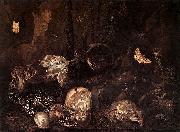 |
Otto Marseus van Schrieck
|
|
(ca. 1619, Nijmegen - buried June 22, 1678, Amsterdam) was a painter in the Dutch Golden Age.
Marseus van Schrieck spent the years 1648-1657 in Rome and Florence with the painters Matthias Withoos and Willem van Aelst, after which he settled in Amsterdam. He is best known for his paintings of forest flora and fauna. In Arnold Houbraken's biography of him, he mentions that he joined the Bentvueghels in Rome and was called the snuffelaer, or "sniffer", because he was always sniffing strange lizards and snakes. He quotes his wife, who apparently survived him by two husbands and was still alive when he wrote the book. He wrote that she said that Otto kept snakes and lizards in a shed at the back of his house, and also on a piece of land outside the city that was walled in for this purpose.
|
|
|
|
|
|
|
|
|
|
|
|
|
|
|
|
|
|
|
|
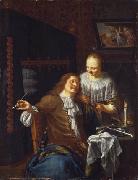 |
Paulus Moreelse
|
|
(1571, Utrecht - 6 March 1638, Utrecht) was a Dutch painter, mainly of portraits.
Moreelse was a pupil of the Delft portrait painter Michiel Jansz. van Mierevelt, who had himself been a pupil of Anthonie van Blocklandt. He took a study-trip to Italy, where he received many portrait commissions. Back in Utrecht, in 1596 he became a member of the zadelaarsgilde, which was the traditional name in Utrecht for the Guild of Saint Luke. In 1611, along with Abraham Bloemaert, he was one of the founders of a new painters' guild, called "St. Lucas-gilde", and became its first deken.
Moreelse was a well known portrait painter who received commissions from right across the Dutch Republic. His earliest work dates to 1606. Other than portraits, he also painted a few history paintings in the Mannerist style and in the 1620s produced pastoral scenes of herders and shepherds. He belonged to the same generation as Abraham Bloemaert and Joachim Wtewael, and like Wtewael he played an important role in the public life of their city. His version of Diana and Callisto was engraved by Jan Saenredam. In 1618, when the anti-remonstrants came to power in Utrecht, he was raadslid.
|
|
|
|
|
|
 |
Peter Monamy
|
|
was an English marine painter who lived between 1681 and 1749.
Peter Monamy was baptised at the church of St Botolph's-without-Aldgate, London, England, on 12 January 1681 (new style). He was the last known surviving child of Peter, or Pierre, Monamy, born 1650 in Guernsey, and his English wife, Dorothy Gilbert; and the grandson of Andre Monamy, 1612-1680, who had been a strongly committed Commonwealth Parliamentarian in Guernsey during the 1650s. Dorothy Gilbert was the daughter of James Gilbert, who was Master of the Worshipful Company of Gunmakers in 1670 and 1672. The Monamy family had been prominent merchants and residents of Guernsey since at least the 1560s, and in the Channel Islands since the 1530s. The painter's father, Pierre, had a brother named Andre, or Andrew, who was active in London as a merchant trader in salt and wool, during the late 17th and early 18th centuries. In December, 1696, Andrew Monamy, together with his cousin, Daniel Le Febvre, is described as "guardian" of the children of Peter (i.e. Pierre) Monamy, deceased. The elder Peter Monamy appears to have died in about 1685.
On 3 September 1696, Peter Monamy, aged 15, was bound as an apprentice for seven years by indenture to William Clark, a former (1687) Master of the Worshipful Company of Painter-Stainers, one of London's ancient guilds of craftsmen. Clark is recorded in several capacities in the London of the late 17th century, as a constable and juryman, with premises in Thames Street, and on London Bridge, and practised as what would today be called an interior decorator, with a thriving business. House decoration comprised a wide range of activities, including the provision of paintings as overdoors, and on panelling, house murals on canvas as well as decorative sign-boards for trade establishments. William Clark died before January, 1704, when his will was proved. |
|
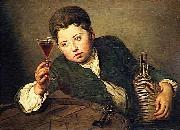 |
Philipe Mercier
|
|
Philippe Mercier (also known as Philip Mercier) (Berlin, 1689 - London, 18 July 1760) was a French painter and etcher, who lived principally and was active in England. He was born in Berlin of French extraction, the son of a Huguenot tapestry-worker. He studied painting at the Akademie der Wissenschaften of Berlin[1] and later under Antoine Pesne, who had arrived in Berlin in 1710. Later, he traveled in Italy and France before arriving in Londone"recommended by the Court at Hannover"eprobably in 1716. He married in London in 1719 and lived in Leicester Fields.
He was appointed principal painter and librarian to the Prince and Princess of Wales at their independent establishment in Leicester Fields, and while he was in favor he painted various portraits of the Royalties, and no doubt many of the nobility and gentry. Of the Royal portraits, those of the Prince of Wales and of his three sisters, painted in 1728, were all engraved in mezzotint by Jean Pierre Simon, and that of the three elder children of the Prince of Wales by the John Faber Junior in 1744. This last was a typical piece of Mercier's composition, the children being made the subject of a spirited, if somewhat childish, allegory in their game of play. Prince George is represented with a firelock on his shoulder, teaching a dog his drill, while his little brother and sister are equally occupied in a scene that is aptly used to point a patriotic moral embodied in some verses subjoined to the plate
|
|
|
|
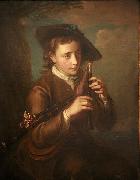 |
Philippe Mercier
|
|
(also known as Philip Mercier) (Berlin, 1689 - London, 18 July 1760) was a French painter and etcher, who lived principally and was active in England. He was born in Berlin of French extraction, the son of a Huguenot tapestry-worker. He studied painting at the Akademie der Wissenschaften of Berlin[1] and later under Antoine Pesne, who had arrived in Berlin in 1710. Later, he traveled in Italy and France before arriving in Londone"recommended by the Court at Hannover"eprobably in 1716. He married in London in 1719 and lived in Leicester Fields.
He was appointed principal painter and librarian to the Prince and Princess of Wales at their independent establishment in Leicester Fields, and while he was in favor he painted various portraits of the Royalties, and no doubt many of the nobility and gentry. Of the Royal portraits, those of the Prince of Wales and of his three sisters, painted in 1728, were all engraved in mezzotint by Jean Pierre Simon, and that of the three elder children of the Prince of Wales by the John Faber Junior in 1744. This last was a typical piece of Mercier's composition, the children being made the subject of a spirited, if somewhat childish, allegory in their game of play. Prince George is represented with a firelock on his shoulder, teaching a dog his drill, while his little brother and sister are equally occupied in a scene that is aptly used to point a patriotic
|
|
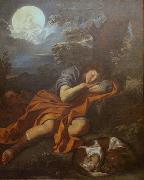 |
Pier Francesco Mola
|
|
(9 February 1612 - 13 May 1666) was an Italian painter of the High Baroque, mainly active around Rome.
Mola was born at Coldrerio (now in Ticino, Switzerland). At the age of four, he moved to Rome with his father Giovanni Battista, a painter. With the exception of the years 1633 - 40 and 1641 - 47, during which he resided in Venice and Bologna, respectively, he lived for the rest of his life in Rome.
His early training was with the late mannerist painter Cavalier D'Arpino, and he worked under the classicizing Francesco Albani.
His masterpiece is the fresco in the gallery of Alexander VII in the Quirinal Palace Gallery, entitled Joseph making himself known to his Brethren (1657). He made six versions of The Flight into Egypt, the earileist and best of which is the first one, The Rest on the Flight into Egypt.
He was elected Principe of the Accademia di San Luca, the Roman artists' professional association, in 1662, but his last years were neither profitable nor prolific. One of his pupils was Antonio Gherardi.
With his looser style and handling, more naturalistic palette, and interest in exploring landscape elements, Mola rebelled against the prevailing, highly-theoretical classicism of such leading 17th-century Roman painters as Andrea Sacchi.
|
|
|
|
|
|
|
|
 |
Pierre Montallier
|
|
(c. 1643 - 15 October 1697) was a French painter.[1] He died in Paris.
|
|
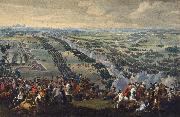 |
Pierre-Denis Martin
|
|
(b. ca. Paris 1663-d. Paris 1742) was a French painter, best known for his paintings of royal residences.
He was also known as "Martin le Jeune" ("Martin the Young") or as "Martin des Gobelins" (because he was employed at the Gobelins Manufactory).
|
|
|
|
 Mondriaan-665953.jpg) |
Pieter Cornelis (Piet) Mondriaan
|
|
(March 7, 1872?CFebruary 1, 1944) was a Dutch painter.
He was an important contributor to the De Stijl art movement and group, which was founded by Theo van Doesburg. He evolved a non-representational form which he termed Neo-Plasticism. |
|
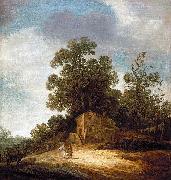 |
Pieter de Molijn
|
|
(6 April 1595 - 23 March 1661) was a Dutch Golden Age painter and engraver born in England.
He was baptized in the Dutch Reformed Austin Friars church in London. Little is known of his early training, but he probably traveled to Italy and in 1616 he became a member of the Haarlem Guild of St. Luke. He was a contemporary of Jacob Pinas. He married Geertuyt Huygen de Bie. During the years 1616-1627 he lived in Delft where he remarried after his first wife died. In the marriage notice, his wife Geertruyt de Roovere is from Amsterdam and he is from Delft.
De Molijn was possibly a student of Esaias van de Velde. He taught several students, including Gerard ter Borch, Jan Coelenbier, Allart van Everdingen, Christian de Hulst, Anthony Molijn, Jan Nose and Jan Wils.De Molijn was known for his landscapes, but he also made genre pieces, marine scenes, portraits, and architectural pieces. This type of oeuvre is typical for the Italian-bound artists of his day, who paid their way as a jack-of-all-trades. De Molijn died in Haarlem on 23 March 1661.
|
|
|
|
|
|
Piotr Michałowski
|
|
(July 2, 1800 - June 9, 1855) was a Polish painter of the Romantic period, especially known for his many portraits.
His talent was long underestimated, but he was re-discovered by Pablo Picasso in 1948. When the painter visited Poland, he saw Michałowski's work in the Warsaw National Museum and shouted, "Here, painter!"
The Sukiennice Museum, a division of the National Museum in Krakew, contains a room devoted to Michałowski's work.
|
|
|
|
 |
Pompeo Mariani
|
|
(Monza, Province of Milan 1857 - Bordighera, Province of Imperia, 1927) was an Italian painter.
The nephew of Mose Bianchi, Mariani abandoned a career in banking to devote himself entirely to painting. His apprenticeship began in 1879 under the guidance of the painter Eleuterio Pagliano, who introduced him to life studies. A trip to Egypt with Uberto DelleOrto in 1881 provided subjects for the works shown at the Brera exhibitions of the next two years. He focused on landscape painting and began to specialise in seascapes in 1883, when he first stayed on the coast of Liguria. The first views of the Zelata area outside Pavia appeared in 1894. His art is characterised by subtle sensitivity in the investigation of the reflection of light on water, captured in different seasons and times of the day to achieve highly atmospheric effects. In was at the beginning of the new century that he began to combine naturalistic landscapes with depictions of the elegant world of high society in fashionable gatherings and cafes. His vast production of landscapes and portraits was regularly presented at the major national and international exhibitions and won numerous official awards.
|
|
|
|
|
|
|
|
|
|
|
|
|
|
 |
Raimundo Madrazo
|
|
(1841, Rome - 1920) was a Spanish realist painter.
He studied painting under his father, Federico de Madrazo, and at the School of the Beaux Arts in Madrid. After 1860 he lived mostly in Paris, where he studied under L??on Cogniet. His remarkable technical ability made him a highly successful portrait painter in a Salon style.
|
|
|
|
|
|
|
|
|







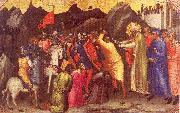


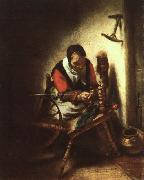


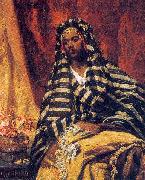
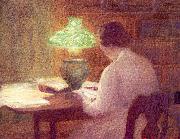
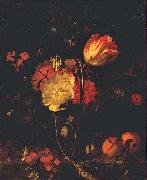
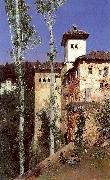

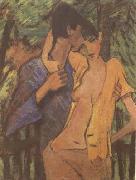
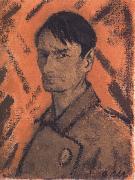
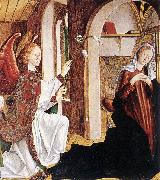
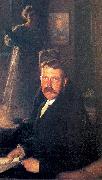
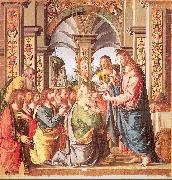
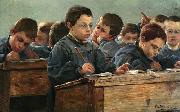
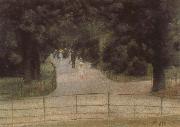
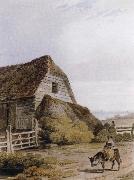
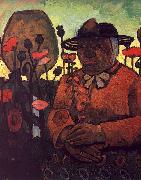

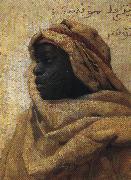
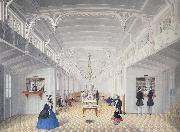


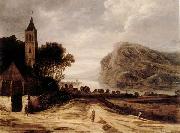


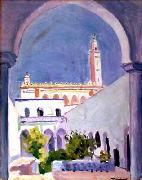
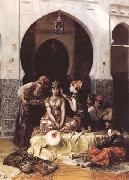
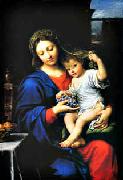


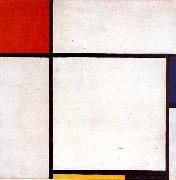
 Mondriaan-665953.jpg)

